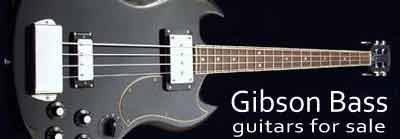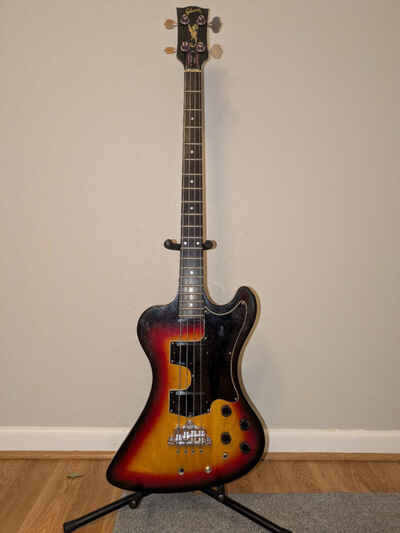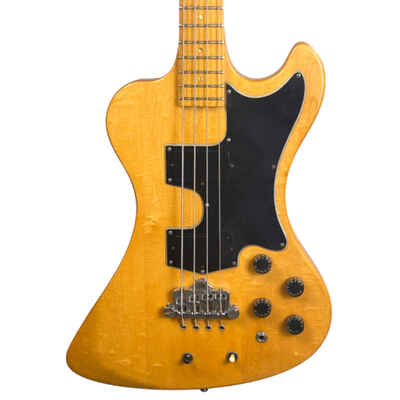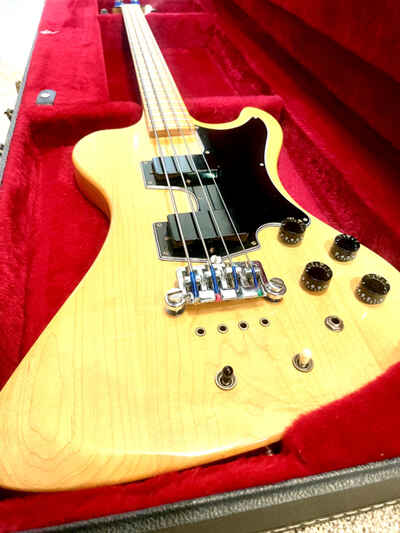Body and neck
Maple body, three-piece maple laminate neck. Maple or Ebony fretboard
|
Body Length 19 9/16" Width 14 5/8" Depth 1 5/8" |
Neck Width at nut 1 5/8" Scale 34 3/8" Frets 20 Headstock pitch 14º |
Total Length 48" Weight 5.2 - 5.3kg |
Gibson RD Electrics
Gibson RD Artist circuit schematic (1977). The schematic is correct for both the RD Artist bass and the RD Artist guitar. The Moog circuit boards for guitar and bass are also identical, and some of the components differ, including two pots attached to the board, which have slightly different shaft lengths to suit the relative body sizes; 1 1/8" for the guitar, and 1 3/8" for the bass.
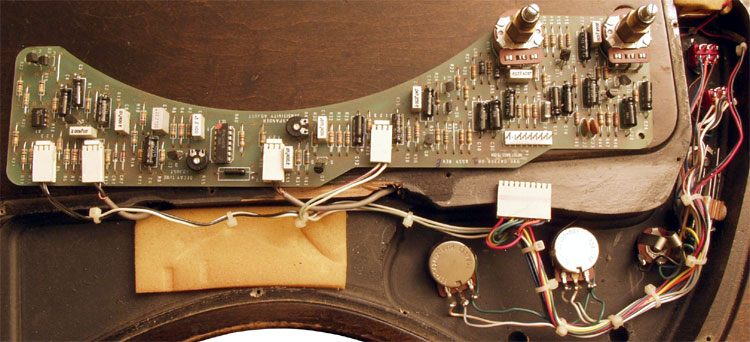
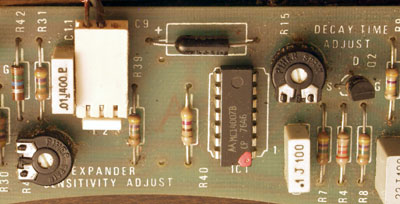
The Moog circuit board has a user changeable setting in the back of the board, the expander sensitivity - this requires a small flat-head screwdriver to adjust. This obviously adjusts the sensitivity in the expansion mode, clockwise adjustment increases sensitivity to pick attack.
There is also one more setting on the top of the board, the decay time control. This is factory set, and inaccessible to the user unless the circuit board is actually removed. The factory setting for this control might be, completely clockwise for bass, and half way round for guitar. Do you know differently?
Switches
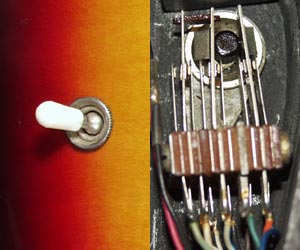
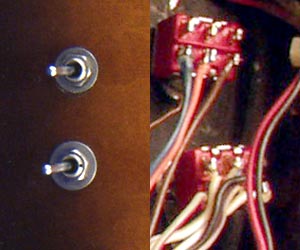
The Moog board for both versions of the RD Artist is identical, although the associated wiring and switching obviously changes between the 1977 and 1979 versions. As can be seen below, the early versions had a 3-way switch (left), and in 1979 this was replaced by two 2-way toggle switches (right). Both images below show the switch from the front, and from within the control cavity. The old 3 way switch was mechanical unreliable and is prone to sticking, though relatively simple to fix with switch cleaner and fine sand paper.
RD Artist bass hardware
Gibson RD parts list (1981) - All the components listed with part numbers
A closer look at the RD Artist and its components
Machine heads Schaller BM, or Schaller M4
Pickguard Five ply - BWBWB
Truss rod cover Inscribed with 'RD ARTIST BASS' in block capitals
Bridge Gibson three point
Pickups Series V humbuckers
Gibson RD bass guitars for sale
Gibson RD Artist Bass
Kitty Hawk, North Carolina, 279**, UNITED STATES OF AMERICA
$2999
... more
Gibson RD Artist MOOG 1978 Natural Maple 4-String Bass w / HSC (Used)
Sedalia, Missouri, 653**, UNITED STATES OF AMERICA
$4000
1978 Gibson RD Artist "NATURAL BLONDE" Electric (MOOG) Bass + OHSC
San Jose, California, 951**, UNITED STATES OF AMERICA
$4000
" NATURAL BLONDE" FINISH
GIBSON NORLIN-ERA
Original MOOG ELECTRONICS
Made in USA (Kalamazoo Plant, MI)
Production # 102 (April 17th release)
Adult owned only. Children-free, Pet-free household. Kept inside case when not used
Up for sale is a BEAUTIFUL LATE-70's Gibson Bass Guitar (RD ARTIST)
EXCELLENT overall vintage condition. Standard surface scratches, light dings, marks on front / back body / ... more
Gibson RD Standard bass Maple Wood 1977 PERFECT
Oakland, California, 946**, UNITED STATES OF AMERICA
$2895
This fantastic instrument was made in 1977, is all original and is in superb almost-new condition!
It has very easy action but does not buzz on the neck. In my opinion it does not need an action set-up. It plays perfectly as is. It was my best friend's brother's who was the sole owner and it has spent most of its time stored in its case
The serial Number is 72697004. This means it was made on the 269th day of 1977 (September 26th,... more
1980 Gibson RD Artist Bass Sunburst
Antioch, Tennessee, 370**, UNITED STATES OF AMERICA
$3999
You say that the three way switch is an easy fix, can you elaborate or provide a link. I know this article is a million years old but my daughter dug out my $100 RD Artist to use as her first guitar and absolutely loves it and I want to keep her going. Thanks
Well, as shown in the image above, the switch just pushes the metal contacts apart, breaking the circuit. It's a straight forward mechanism but they can get a little sticky. Take the back cover off and operate the switch, preferably plugged in and amplified. You should see what the switch does, and whether the contacts are sticking. If so try switch cleaner or use fine sandpaper between the contacts to remove oxidation. BE CAREFUL NOT TO BEND THE CONTACTS.
Hi can you help i have a Gibson GK55 Les Paul 1980 which has moog circuit board which has been removed .. ( i have this )but id like to replace it back in but cant find any diagrams. there is a flicker pic but can't see how to wire it back please help


